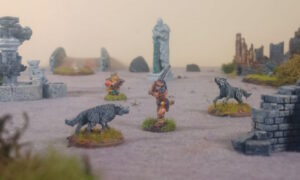 The title 2d Delves does not, it turns out, refer to the number of dimensions involved in the game. That’s a good sign for a miniature wargame as those generally require the use of a third dimension. Instead, the 2d relates to the dice involved. Most of the melee and skill and shooty and magic checks involve a simple 2d6 rolled against a toughness number. As usual, your stats and magic items and situational modifiers apply to this roll. If you’re playing an opponent, you compare rolls and the difference becomes the degree of success. Beating your opponent by three means you do three extra points of damage. Beating a jumping test by four means jumping an extra two inches. You get it. Nice and simple, easy to learn and easy to play.
The title 2d Delves does not, it turns out, refer to the number of dimensions involved in the game. That’s a good sign for a miniature wargame as those generally require the use of a third dimension. Instead, the 2d relates to the dice involved. Most of the melee and skill and shooty and magic checks involve a simple 2d6 rolled against a toughness number. As usual, your stats and magic items and situational modifiers apply to this roll. If you’re playing an opponent, you compare rolls and the difference becomes the degree of success. Beating your opponent by three means you do three extra points of damage. Beating a jumping test by four means jumping an extra two inches. You get it. Nice and simple, easy to learn and easy to play.
The movement system is likewise familiar ground to any moderately experienced wargamer. No surprises, it just does what it needs to do and gets out of the way.
 The initiative system is a little more novel, and a little more involved. The game uses a chit-pull mechanic, with each figure being given a random chit and hence a random place in the turn order. You lay out all the initiative markers next to the figure, and that lets you look at the table and generally see how the turn is going to go. You can hold a figure’s activation until later in the turn, and this gives you a chance to cut in line. The trick is that the figure has to pass a perception check to act, and if it fails then it still has to activate – but it activates after the figure it was hoping to interrupt. This gives you a little more control over activation order, but it comes with some risks. Meaningful choices are fun.
The initiative system is a little more novel, and a little more involved. The game uses a chit-pull mechanic, with each figure being given a random chit and hence a random place in the turn order. You lay out all the initiative markers next to the figure, and that lets you look at the table and generally see how the turn is going to go. You can hold a figure’s activation until later in the turn, and this gives you a chance to cut in line. The trick is that the figure has to pass a perception check to act, and if it fails then it still has to activate – but it activates after the figure it was hoping to interrupt. This gives you a little more control over activation order, but it comes with some risks. Meaningful choices are fun.
As a side note, there are magical means to swap initiative tokens at the start of the turn, which gives you even more control over initiative order. This comes with the opportunity cost of using up a spell slot on initiative that you might have wanted for the flashier boom-boom spells.
When you’re playing solo, however, that’s when the simplicity of the core mechanics really starts to show what it can do. Instead of a roll-off, the player controlled figures become the active party at all times. The opposition models have static toughness numbers for attack and defense, meaning that your figures:
- On attack have to succeed on a strength check against the target’s dexterity
- On defense have to succeed on a dexterity check against the target’s strength
It’s faster and easier to implement than a roll-off system such as Rangers of Shadowdeep, to which this game might favorably be compared. The couple of games that I’ve played so far take 15-20 minutes to set up and about the same amount of time to resolve. The campaign interlude takes about the same amount of time, but that’s a subject for another post.
Anyway, you can get a hard copy at the usual places, and order a rare spiral-bound copy from the publisher, Four Color Studios.


One thought on “The Basics of 2d Delves”
Comments are closed.